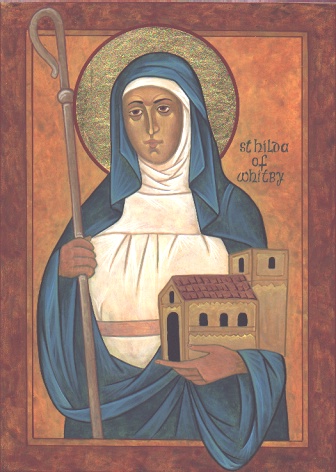St. Hilda of Whitby
613-November 17, 680
“maintain the gospel peace”
St. Hilda of Whitby’s Resurrection day, was November 17, 680. She died at the age of 66, after serving God with creativity, energy, strength, and courage in spite of a six year debilitating illness. Her final words as Abbess to her nuns and monks were “to maintain the gospel peace among themselves and with others.” Those words still ring true to us almost 1,400 years later.
Hilda was the 7th c. Abbess/founder of double monasteries. This was a Celtic way of monastic living that included monks and nuns in the same monastery in separate small houses, but worshiping together in the abbey church. Hilda is known to us mainly through The Venerable Bede’s Ecclesiastical History of the English People. There was something so intriguing about Hilda’s devoted life of faith, work, and grace that Bede wrote with unabashed admiration about this Abbess. He also records that Hilda was so loved and respected that everyone who knew her called her “Mother.” Bede himself described her as “Christ’s servant” and that many came to salvation through hearing of her industry and goodness. He also wrote of her emphasis on learning and literacy, scholarly study of the Bible, good works, holding all things in common, and living with one another in peace and love. Five Bishops of early England were trained under her tutelage.
Hilda was born into the royal Deiran household, the great-niece of King Edwin of Northumbria and the daughter of Hereric and his wife Breguswith. Bede includes a story in which Breguswith while pregnant with Hilda, dreamed that she discovered a precious jewel under her garment. When she gazed at the jewel it flashed a blaze of light that illuminated all Britain with its splendor. Breguswith sensed that this was a prophetic dream about her daughter Hilda who would bring light to the isle of Britain.
Hilda was baptized at age 14 alongside King Edwin and his extended family by St. Paulinus in the especially built wooden York Minster on Easter Sunday, April 12 in 627. Almost twenty years later, she was in East Anglia for a year preparing to travel by ship to France to join her sister, the former Queen Hereswith of East Anglia who was living in a convent east of Paris. However, when St. Aidan, the first Bishop of Lindisfarne heard of this, he pleaded with her to stay in England to establish a small monastery north of the River Wear. This was quite likely where St. Hilda’s Church, South Shields is located now.
After Aidan saw her great ability to administer and spiritually lead a small monastery, a year later, about 649, he persuaded her to become the second Abbess of the monastery at Hartlepool. Eight years later, King Oswiu gave Hilda about 1,200 acres of land called Streanaesalch, later known as Whitby. He wished for her to build a double monastery there and to raise his infant daughter, princess Æfflæd. The famous Synod of Whitby that dramatically reshaped the Celtic way of life was held here in 664.
Hilda was a supporter of the arts, music, and learning. Bede records that Caedmon, a cow herder on her monastic lands who had some ways with words and music was brought to her to hear. Hilda recognized his gift from God and encouraged him to stay at the monastery to learn the Bible stories and to create them into poetry and song. She perceived that teaching the Bible in the vernacular instead of Latin would help bring the people of the area to Christ. Through this encounter with Hilda, Cædmon became the first English poet.
On the night of Hilda’s death and resurrection, something rather mystical occurred. It was one of those Celtic thin places where the veil between heaven and earth seems almost gossamer. Begu, a nun at Hilda’s most recently established convent of Hackness, saw a vision of the roof opened and Hilda’s soul carried to heaven by angels. Begu told the Prioress of her vision and they all began to pray. It is even said that the bells at Hackness rang on their own at her death. While these nuns were in prayer, the monks from Whitby rushed over to Hackness to inform them of Hilda’s death. The monks discovered that the nuns were already aware of her death because of Begu’s vision. Hilda was most likely buried at Whitby and her relics later taken to Glastonbury to protect them from the 9th c. Viking raids on Whitby.
Hilda’s legacy lives on through hundreds of schools, colleges, priories, and churches throughout the world bearing her name. At Lindisfarne, the “Community of Aidan and Hilda,” a dispersed international ecumenical community of men and women, has their office and a retreat center. In June of 2015, the 43 mile “St. Hilda’s Way” in Northeast England that extends from Hinderwell in Yorkshire to Whitby Abbey was opened. This pilgrimage path visits eight churches and chapels all dedicated to St. Hilda.
Thank you God for St. Hilda and her courageous good work of establishing beacons of learning, literacy, and light, bringing new life in Christ to the Anglo-Saxons. May we hear and allow those last words of St. Hilda to penetrate our lives and our souls so that we too may “maintain the gospel peace among ourselves and with others.”
Further information on St. Hilda of Whitby and other Celtic and Anglo-Saxon saints can be found at www.saintsbridge.org.
Photo above: By Carolyn Custis James – https://carolyncustisjames.com/2012/11/19/happy-st-hildas-day/, Public Domain, https://en.wikipedia.org/w/index.php?curid=64601882


1 comment
[…] “St. Hilda of Whitby…maintaining the gospel peace.” November 17, 2016. […]